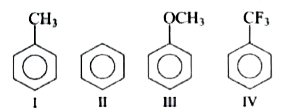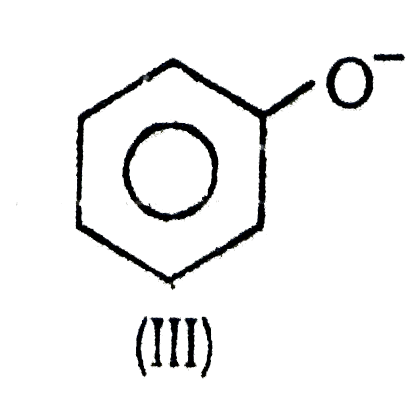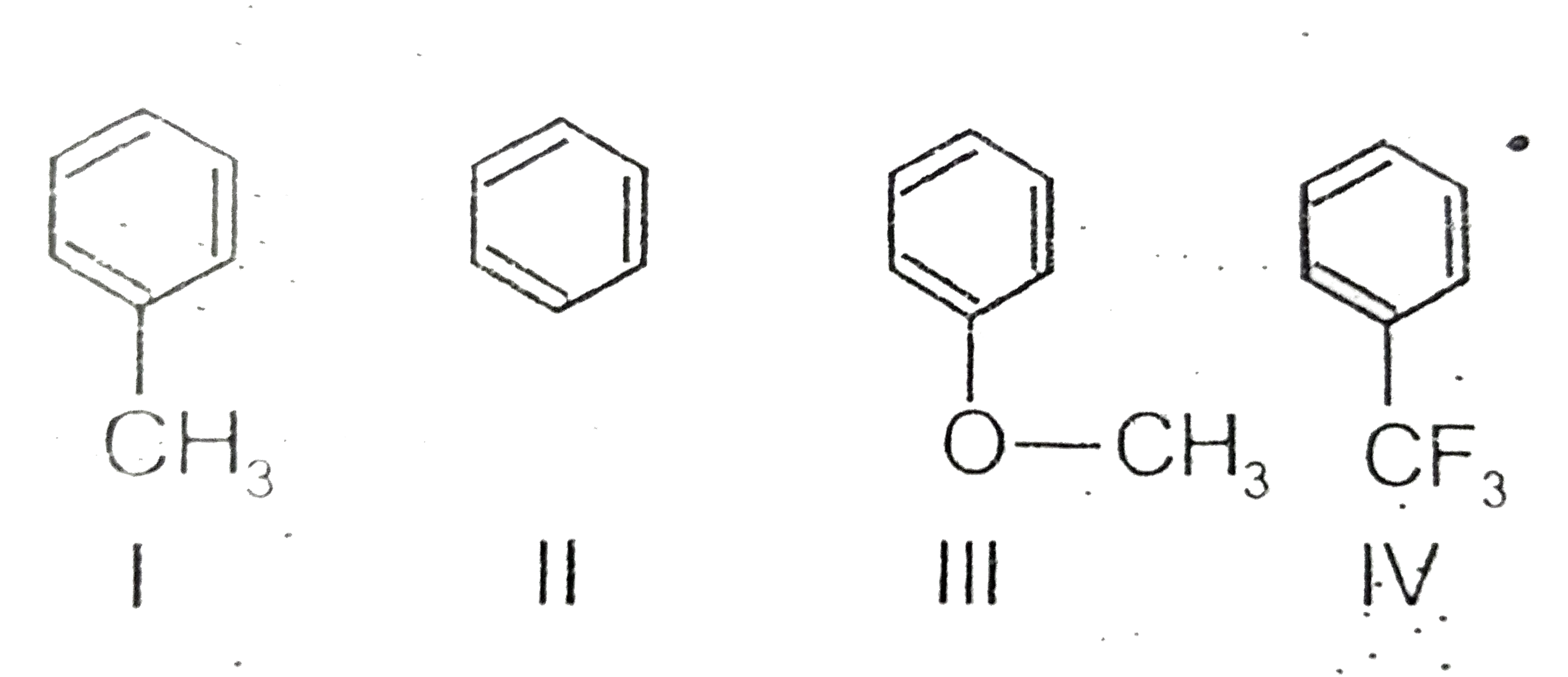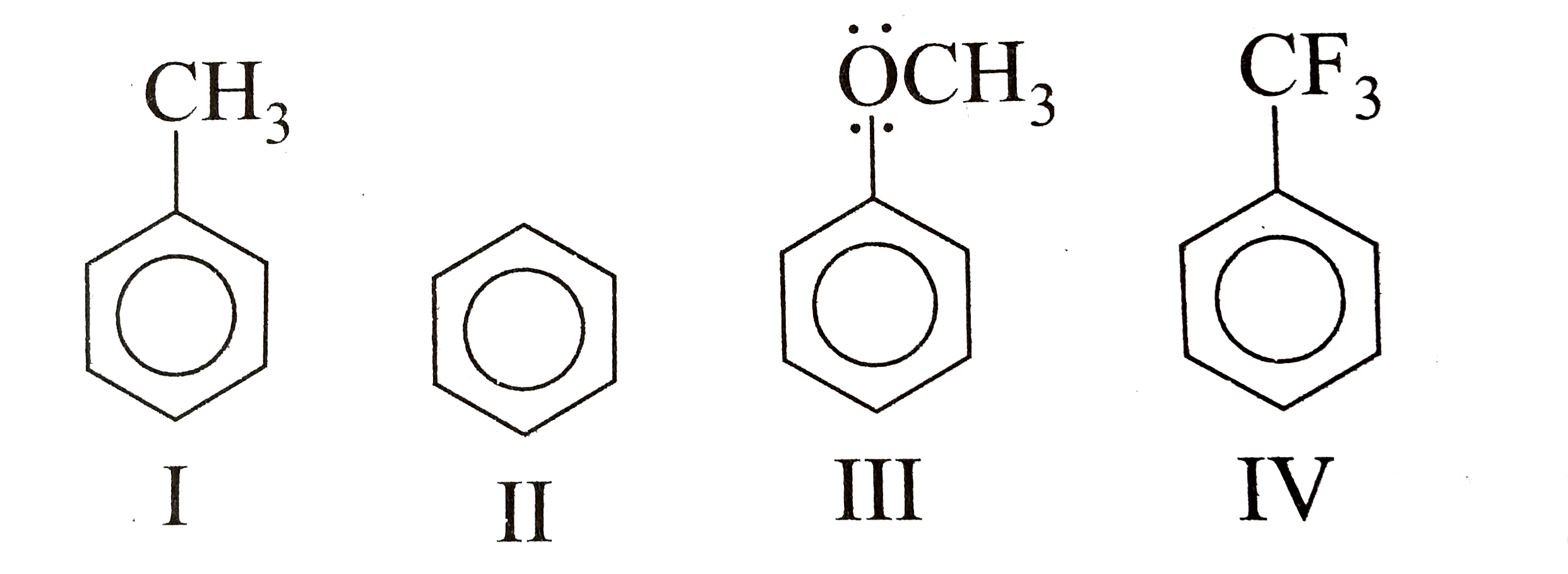In Chlorobenzene(I),2,4-dinitrochlorobenzene(II),p- nitrochlorobenzene(III)
The decreasing order of reactivity towards electrophliic substitution reaction is
(I) gt (II) gt (III)
(I) gt (III) gt (II)
(II) gt (I) gt (III)
(III) gt (I) gt (II)
The correct Answer is:2
To determine the decreasing order of reactivity towards electrophilic substitution reactions for the compounds chlorobenzene, 2,4-dinitrochlorobenzene, and p-nitrochlorobenzene, we need to analyze the effects of substituents on the benzene ring.
1. Identify the Compounds:
- (I) Chlorobenzene
- (II) 2,4-Dinitrochlorobenzene
- (III) p-Nitrochlorobenzene
2. Understand Electrophilic Substitution:
- Electrophilic substitution involves an electrophile attacking the benzene ring, resulting in the substitution of a hydrogen atom. The reactivity of the benzene ring towards electrophiles depends on the nature of the substituents already present on the ring.
3. Determine the Nature of Substituents:
- Chlorobenzene (I): The chlorine atom is a weakly activating group due to its +R (resonance) effect, which increases electron density at the ortho and para positions. However, it also has a -I (inductive) effect, which is electron-withdrawing. The overall effect is that chlorobenzene is moderately reactive towards electrophilic substitution.
- 2,4-Dinitrochlorobenzene (II): The nitro groups (-NO2) are strong deactivating groups due to their -I and -R effects. They withdraw electron density from the ring, significantly decreasing the reactivity towards electrophilic substitution. Since there are two nitro groups at the 2 and 4 positions, the reactivity is very low.
- p-Nitrochlorobenzene (III): This compound has one nitro group and one chlorine atom. The nitro group is deactivating, but the chlorine atom still provides some activating effect through resonance. However, the overall effect is still deactivating, but less so than in the case of 2,4-dinitrochlorobenzene.
4. Rank the Reactivity:
- The order of reactivity towards electrophilic substitution can be determined by considering the overall electron density on the benzene ring:
- Chlorobenzene (I): Most reactive due to the weakly activating effect of chlorine.
- p-Nitrochlorobenzene (III): Less reactive than chlorobenzene but more reactive than 2,4-dinitrochlorobenzene due to the presence of only one nitro group.
- 2,4-Dinitrochlorobenzene (II): Least reactive due to the strong deactivating effect of two nitro groups.
5. Final Order:
- The decreasing order of reactivity towards electrophilic substitution is:
- Chlorobenzene (I) > p-Nitrochlorobenzene (III) > 2,4-Dinitrochlorobenzene (II)
Conclusion:
The correct sequence is:
Chlorobenzene (I) > p-Nitrochlorobenzene (III) > 2,4-Dinitrochlorobenzene (II).
- (I) Chlorobenzene
- (II) 2,4-Dinitrochlorobenzene
- (III) p-Nitrochlorobenzene
- Electrophilic substitution involves an electrophile attacking the benzene ring, resulting in the substitution of a hydrogen atom. The reactivity of the benzene ring towards electrophiles depends on the nature of the substituents already present on the ring.
- Chlorobenzene (I): The chlorine atom is a weakly activating group due to its +R (resonance) effect, which increases electron density at the ortho and para positions. However, it also has a -I (inductive) effect, which is electron-withdrawing. The overall effect is that chlorobenzene is moderately reactive towards electrophilic substitution.
- 2,4-Dinitrochlorobenzene (II): The nitro groups (-NO2) are strong deactivating groups due to their -I and -R effects. They withdraw electron density from the ring, significantly decreasing the reactivity towards electrophilic substitution. Since there are two nitro groups at the 2 and 4 positions, the reactivity is very low.
- p-Nitrochlorobenzene (III): This compound has one nitro group and one chlorine atom. The nitro group is deactivating, but the chlorine atom still provides some activating effect through resonance. However, the overall effect is still deactivating, but less so than in the case of 2,4-dinitrochlorobenzene.
- The order of reactivity towards electrophilic substitution can be determined by considering the overall electron density on the benzene ring:
- Chlorobenzene (I): Most reactive due to the weakly activating effect of chlorine.
- p-Nitrochlorobenzene (III): Less reactive than chlorobenzene but more reactive than 2,4-dinitrochlorobenzene due to the presence of only one nitro group.
- 2,4-Dinitrochlorobenzene (II): Least reactive due to the strong deactivating effect of two nitro groups.
- The decreasing order of reactivity towards electrophilic substitution is:
- Chlorobenzene (I) > p-Nitrochlorobenzene (III) > 2,4-Dinitrochlorobenzene (II)
The correct sequence is:
Chlorobenzene (I) > p-Nitrochlorobenzene (III) > 2,4-Dinitrochlorobenzene (II).
Topper's Solved these Questions
- HYDROCARBONSBOOK - AAKASH INSTITUTE ENGLISHCHAPTER - HYDROCARBONSEXERCISE - Assignment(Section - B) (Obejctive type question)
5 Videos
- HYDROCARBONSBOOK - AAKASH INSTITUTE ENGLISHCHAPTER - HYDROCARBONSEXERCISE - Assignment(Section - C) (Previous Years Questions)
60 Videos
- HYDROCARBONSBOOK - AAKASH INSTITUTE ENGLISHCHAPTER - HYDROCARBONSEXERCISE - Exercise
33 Videos
- HALOALKANES AND HALOARENES BOOK - AAKASH INSTITUTE ENGLISHCHAPTER - HALOALKANES AND HALOARENES EXERCISE - ASSIGNMENT SECTION -D
15 Videos
- HYDROGENBOOK - AAKASH INSTITUTE ENGLISHCHAPTER - HYDROGENEXERCISE - ASSIGNMENT (SECTION - D) (Assertion-Reason Type question)
15 Videos
Similar Questions
Knowledge Check
Among the compounds the order of decreasing reactivity towards electrophilic substitution is :
 AII>I>III>IVBIII>I>II>IVCIIIgI>IV>IIDII>I>IV>III
AII>I>III>IVBIII>I>II>IVCIIIgI>IV>IIDII>I>IV>IIIArrange the following in decreasing order of reactivity towards EAS (electrophilic aromatic substitution)
 Aa gt b gt cBc gt b gt aCa gt c gt bDc gt a gt b
Aa gt b gt cBc gt b gt aCa gt c gt bDc gt a gt bThe decreasing order of reactivity of given compound towards nucleophilic substitution with aqueous NaOH is :
 AI gt II gt III gt IVBII gt I gt III gt ICIV gt II gt III gt IDII gt IV gt I gt III
AI gt II gt III gt IVBII gt I gt III gt ICIV gt II gt III gt IDII gt IV gt I gt III
Which of the following compounds are not arranged in order of decreasing reactivity towards electrophilic substitution
View SolutionIn
−NO2(i),−NH2(ii),−SO3H(iii) ,
The decreasing order of -I effect is
View SolutionArrange the following in decreasing order of reactivity towards electrophilic substitution reaction
Aniline (I) , Acetanilide (II)
phenol (III) , Anilinium chloride (IV)
View SolutionConsider the following anions.
(I) CF3−O∣∣S∣∣O−O− (II) C6H5−O∣∣S∣∣O−O− (III) (IV) CH3−O∣∣C−O−
(IV) CH3−O∣∣C−O−
When attached to sp3-hybridized carbon, their leaving group ability in nucleophilic substitution reactions decreases in the order
View SolutionConsider the following akohols

The order of decreasing reactivities of these alcohols towards substitution with HBr is :
View Solution


